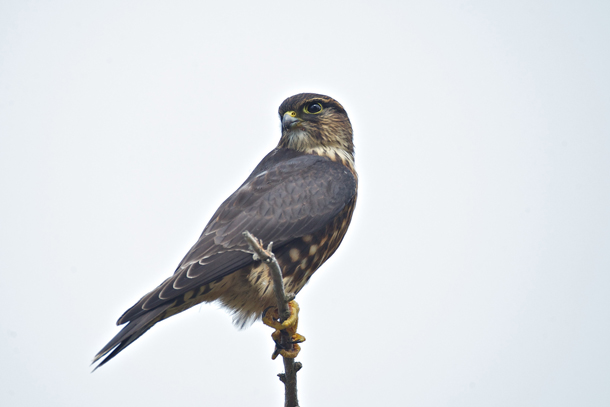Birdnote®: Here Come the Merlins
Air Date: Week of October 4, 2024

The Merlin may be small, but it packs a serious punch. In Medieval times, nobility used the bird to hunt sky larks. (Photo: Greg Thompson)
The Merlin is one of the world’s smallest falcons yet it’s something of a trailblazer. Rising global temperatures are forcing many species to head north, but as BirdNote®’s Mary McCann reports, these adaptive predators have begun to move south to occupy the abandoned homes of other avian migrants.
Transcript
CURWOOD: It’s Living on Earth, I’m Steve Curwood.
DOERING: And I’m Jenni Doering.
[BIRDNOTE THEME]
DOERING: They are tiny birds, but tough ones. And they are flying against the trend of wildlife moving toward the poles as the planet warms, as Mary McCann tells us in today’s BirdNote®.
[BirdNote®]
Here Come the Merlins.
[Merlin calling, https://macaulaylibrary.org/audio/197047, 0.19-.22]
MCCANN: Want to see one of the blazing thunderbolts of the bird world? Smaller than a pigeon — but fierce enough to knock one from the air — are the powerful, compact falcons known as Merlins. While global climate change is pushing ranges of many birds farther north, Merlins are actually expanding southward.
Merlins nest in northern forests around the world. But in recent years, more and more Merlins have been nesting farther south, in towns and cities across the northern United States. These small falcons will take over old crow nests, especially in conifer trees — in parks, cemeteries, and neighborhoods.
[Merlin calling, https://macaulaylibrary.org/audio/197047, 0.19-.22]
No one knows precisely why, but part of the answer may lie in a rebound of Merlin populations since the banning of pesticides like DDT. And it’s a reminder that bird behavior may be more flexible than we sometimes imagine.
[Merlin call, https://macaulaylibrary.org/audio/105837, 0.15-.17]
Merlins reach their peak southward migration in October. Although some, like those in the Pacific Northwest, remain year-round, most scatter to the south for winter. Some travel as far as Ecuador. With any luck, you might see these adaptable, pint-sized thunderbolts in your neighborhood.
[Merlin call, https://macaulaylibrary.org/audio/105837, 0.15-.17]
###
Written by Bob Sundstrom
Bird sounds provided by The Macaulay Library of Natural Sounds at the Cornell Lab of Ornithology, Ithaca, New York. Recorded by Bob McGuire and Geoffrey A Keller.
BirdNote’s theme music was composed and played by Nancy Rumbel and John Kessler.
Producer: John Kessler
Managing Producer: Jason Saul
Associate Producer: Ellen Blackstone
© 2017 Tune In to Nature.org October 2017 Narrator: Mary McCann
DOERING: For pictures, soar on over to the Living on Earth website, loe dot org.
Links
Living on Earth wants to hear from you!
Living on Earth
62 Calef Highway, Suite 212
Lee, NH 03861
Telephone: 617-287-4121
E-mail: comments@loe.org
Newsletter [Click here]
Donate to Living on Earth!
Living on Earth is an independent media program and relies entirely on contributions from listeners and institutions supporting public service. Please donate now to preserve an independent environmental voice.
NewsletterLiving on Earth offers a weekly delivery of the show's rundown to your mailbox. Sign up for our newsletter today!
 Sailors For The Sea: Be the change you want to sea.
Sailors For The Sea: Be the change you want to sea.
 The Grantham Foundation for the Protection of the Environment: Committed to protecting and improving the health of the global environment.
The Grantham Foundation for the Protection of the Environment: Committed to protecting and improving the health of the global environment.
 Contribute to Living on Earth and receive, as our gift to you, an archival print of one of Mark Seth Lender's extraordinary wildlife photographs. Follow the link to see Mark's current collection of photographs.
Contribute to Living on Earth and receive, as our gift to you, an archival print of one of Mark Seth Lender's extraordinary wildlife photographs. Follow the link to see Mark's current collection of photographs.
 Buy a signed copy of Mark Seth Lender's book Smeagull the Seagull & support Living on Earth
Buy a signed copy of Mark Seth Lender's book Smeagull the Seagull & support Living on Earth

